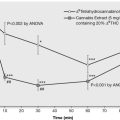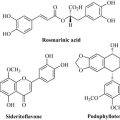Chapter 22 The skin
Dry/itchy skin conditions and eczema
Oats, avena sativa L.
Therapeutic uses and available evidence
Oats are externally emollient, and a colloidal fraction is used in bath preparations for eczema, and itchy or dry skin, often with success, especially if used regularly over a long period. Cells treated with avenanthramides showed a significant inhibition of TNF-alpha-induced NF-kappaB activity and subsequent reduction of interleukin-8 (IL-8) release. Topical application of avenanthramides mitigated inflammation in murine models of contact hypersensitivity and neurogenic inflammation and reduced pruritogen-induced scratching in a murine itch model. Avenanthramides are thus potent antiinflammatory agents that appear to mediate the anti-irritant effects of oats (Sur et al 2008). The many clinical properties of colloidal oatmeal derive from its variety of chemical constituents: the starches and beta-glucans are responsible for the protective and water-holding functions of oat and the presence of phenolics confers antioxidant and antiinflammatory activity. Some of the oat phenols are also strong ultraviolet absorbers and the cleansing activity of oat is mostly due to saponins (Kurtz and Wallo 2007). Together, these make colloidal oatmeal a cleanser, moisturizer, buffer, as well as a soothing and protective antiinflammatory agent (for review, see Cerio et al 2010).
Inflammatory skin conditions
Aloe vera, aloe barbadensis mill. [syn. aloe vera (L.) burm. f.]
Therapeutic uses and available evidence
Aloe vera gel is used mainly in the form of the pure gel, applied as a lotion. It may be stabilized and a preservative added for this purpose. For dermatological preparations, there is some evidence for antibacterial, antiinflammatory, emollient and moisturizing effects. The polysaccharides are important as soothing and immunostimulating agents. Some of the glycoproteins have similar effects, while the anthraquinone derivatives are antibacterial. Enzymes extracted from aloe vera gel have been shown to be analgesic and inhibit thermal damage and vascular permeability in mice. The fresh leaf pulp is antioxidant and induces carcinogen-metabolizing phase I enzymes. The gel has been reported to be effective in the treatment of stomach and aphthous (mouth) ulcers. Although few good clinical studies are available, aloe vera gel seems to be helpful in the treatment of burns and to aid wound healing (for review, see Maenthaisong et al 2007). Aloe vera cream was found to be at least as effective as 0.1% triamcinolone acetonide in reducing the clinical symptoms of psoriasis in a recent study (Choonhakarn et al 2010), and in UV-induced erythema, aloe vera gel (97.5%) displayed some antiinflammatory effects superior to those of 1% hydrocortisone in placebo gel (Reuter et al 2008), supporting its use as an after-sun treatment and post-radiotherapy emollient.
Evening primrose oil, Oenothera biennis L. (Oenothera biennis oleum) and other spp.
Constituents
The seed oil contains about 70% cis-linoleic acid and about 9% cis-γ-linolenic acid (Fig. 22.1).
Therapeutic uses and available evidence
The fatty oil has been extensively investigated, and its therapeutic benefits ascribed mainly to the γ-linolenic acid content. It is taken internally as well as applied externally. Supplementation with omega-6 essential fatty acids (omega-6 EFAs) is of potential interest in the treatment of atopic dermatitis since patients with atopic dermatitis have been reported to have imbalances in EFA levels. EFAs play a vital role in skin structure and physiology, and deficiency replicates the symptoms of atopic dermatitis. To date, most studies of EFA supplementation in atopic dermatitis have produced conflicting results, although a systematic review has concluded that evening primrose oil has a simultaneous, beneficial effect on itching, crusting, oedema and redness that becomes apparent between 4 and 8 weeks after treatment is initiated. This effect is said to be reduced in association with increasing frequency of potent steroid use (Morse and Clough 2006). The main indications for which clinical evidence exists are: atopic eczema (especially in infants), mastalgia, rheumatoid arthritis and premenstrual syndrome, although the evidence of efficacy is equivocal. Evening primrose oil is usually taken in conjunction with vitamin E to prevent oxidation.
Note: The seed oil of Borago officinalis L. (borage, Boraginaceae), also known as Star Flower oil, is used in a similar way to evening primrose oil, but contains 2–3 times more γ-linolenic acid. It seems to provide some benefit to patients with atopic eczema (Foster et al 2010).
Marigold, calendula officinalis L. (calendulae flos) 
Therapeutic uses and available evidence
Pharmaceutical uses include inflammatory skin conditions such as topical application for wound healing and after radiotherapy. The flower heads and extracts from them are well known for their antiinflammatory properties, which are mainly due to the lipophilic triterpene alcohols, notably the esters of faradiol. These were demonstrated using in vitro models such as phorbol ester induced mouse ear oedema or croton oil induced irritation. Marigold extract prevented UVB irradiation-induced GSH depletion in the skin of hairless mice after oral administration and increased gelatinase activity, which may be beneficial for skin healing and pro-collagen synthesis (Fonseca et al 2010). Both oral and topical application of Calendula flower extract improved healing of excision wounds in rats and reduced the time needed for re-epithelization (Preethi and Kuttan 2009). Extracts stimulated proliferation and migration of fibroblasts at low concentrations (Fronza et al 2009), again supporting its use in wound healing, while the essential oil exerts (in vitro) antibacterial and antifungal effects. Immunostimulant effects have been reported for polysaccharide fractions. Few clinical studies are available to further validate these pharmacological data, although some preliminary studies indicate efficacy.
Witch hazel, hamamelis virginiana L. (hamamelis folium, and hamamelis folium et cortex) 
Therapeutic uses and available evidence
Witch hazel is widely used for the treatment of haemorrhoids, bruises, skin irritation, spots and blemishes and redness of the eye. Hamamelitannin inhibits TNF-mediated endothelial cell death without altering TNF-induced upregulation of endothelial adhesiveness (Habtemariam 2002), which may explain the anti-haemorrhagic use. The proanthocyanidins, gallotannins and gallates are highly active as free radical scavengers. Witch hazel phenolics protected red blood cells from free radical-induced haemolysis and were mildly cytotoxic to 3T3 fibroblasts and HaCat keratinocytes; they also inhibited the proliferation of tumoral SK-Mel 28 melanoma cells at lower concentrations than grape and pine procyanidins (Touriño et al 2008).
Antiviral activity against Herpes viruses has been shown, and several clinical studies have demonstrated efficacy of topically applied witch hazel in inflammatory conditions, including UV-irradiated burning and atopic dermatitis (Hughes-Formella et al 2002). An observational study in children (age 27 days to 11 years) with minor skin injuries, diaper dermatitis, or localized inflammation of skin found hamamelis ointment to be as effective as dexpanthenol, and concluded that hamamelis ointment is an effective and safe treatment for certain skin disorders in children up to the age of 11 years (Wolff and Kieser 2007). However, a review of the literature of hamamelis water in women suffering episiotomy pain following childbirth found it to confer no advantage over ice packs (East et al 2007). Witch hazel is used in after-shave lotions and in cosmetic preparations.
Wound healing
Centella asiatica (L.) urban (centellae herba) 
Therapeutic uses and available evidence
A wide range of pharmacological effects have been reported, including as a general tonic (see also Chapter 25), the most important being its use in skin conditions, including wound healing, inflammation, psoriasis, keloid and the prevention of stretch marks during pregnancy. Creams containing extracts are applied topically, but the herb is also taken internally for mental disorders, to improve memory, for atherosclerosis and to improve venous insufficiency and microangiopathy (for review, see Brinkhaus et al 2000).
Despite the lack of clinical studies, pharmacological studies support the use of Centella in skin conditions. Extracts have been shown to significantly increase the wound breaking strength in a rat incision wound model, improving the rate of epithelization and wound contraction (Shetty et al 2006). Different constituents affect the different phases of wound repair: the triterpenes stimulated extracellular matrix accumulation in rat experimental wounds (Coldren et al 2003), whereas asiatic acid stimulated collagen synthesis, and madecassoside increased collagen secretion (Lee et al 2006). Centella has been suggested as a topical anti-psoriatic agent, and extracts have been shown to inhibit keratinocyte replication. The effect was thought to be due to its two constituent triterpenoid glycosides madecassoside and asiaticoside (Sampson et al 2001).
Brinkhaus B., Lindner M., Schuppan D., Hahn E.G. Chemical, pharmacological and clinical profile of the East Asian medical plant Centella asiatica. Phytomedicine. 2000;7:427-448.
Cerio R., Dohil M., Jeanine D., Magina S., Mahé E., Stratigos A.J. Mechanism of action and clinical benefits of colloidal oatmeal for dermatologic practice. J. Drugs Dermatol.. 2010;9:1116-1120.
Choonhakarn C., Busaracome P., Sripanidkulchai B., Sarakarn P. A prospective, randomized clinical trial comparing topical aloe vera with 0.1% triamcinolone acetonide in mild to moderate plaque psoriasis. J. Eur. Acad. Dermatol. Venereol.. 2010;24:168-172.
Coldren C.D., Hashim P., Ali J.M., Oh S.K., Sinskey A.J., Rha C. Gene expression changes in the human fibroblast induced by Centella asiatica triterpenoids. Planta Med.. 2003;69:725-732.
East C.E., Begg L., Henshall N.E., Marchant P., Wallace K. Local cooling for relieving pain from perineal trauma sustained during childbirth. Cochrane Database Syst. Rev. 4, 2007. CD006304
Fonseca Y.M., Catini C.D., Vicentini F.T., Nomizo A., Gerlach R.F., Fonseca M.J. Protective effect of Calendula officinalis extract against UVB-induced oxidative stress in skin: evaluation of reduced glutathione levels and matrix metalloproteinase secretion. J. Ethnopharmacol.. 2010;127:596-601.
Foster R.H., Hardy G., Alany R.G. Borage oil in the treatment of atopic dermatitis. Nutrition. 2010;26:708-718.
Fronza M., Heinzmann B., Hamburger M., Laufer S., Merfort I. Determination of the wound healing effect of Calendula extracts using the scratch assay with 3T3 fibroblasts. J. Ethnopharmacol.. 2009;126:463-467.
Habtemariam S. Hamamelitannin from Hamamelis virginiana inhibits the tumour necrosis factor-alpha (TNF)-induced endothelial cell death in vitro. Toxicon. 2002;40:83-88.
Hughes-Formella B.J., Filbry A., Gassmueller J., Rippke F. Anti-inflammatory efficacy of topical preparations with 10% hamamelis distillate in a UV erythema test. Skin Pharmacol. Appl. Skin Physiol.. 2002;15:125-132.
Kurtz E.S., Wallo W. Colloidal oatmeal: history, chemistry and clinical properties. J. Drugs Dermatol.. 2007;6:167-170.
Lee J., Jung E., Lim J., et al. Asiaticoside induces human collagen I synthesis through TGFbeta receptor I kinase (TbetaRI kinase)-independent Smad signaling. Planta Med.. 2006;72:324-328.
Maenthaisong R., Chaiyakunapruk N., Niruntraporn S., Kongkaew C. The efficacy of aloe vera used for burn wound healing: a systematic review. Burns. 2007;33:713-718.
Morse N.L., Clough P.M. A meta-analysis of randomized, placebo-controlled clinical trials of Efamol evening primrose oil in atopic eczema. Where do we go from here in light of more recent discoveries? Curr. Pharm. Biotechnol.. 2006;7:503-524.
Preethi K.C., Kuttan R. Wound healing activity of flower extract of Calendula officinalis. J. Basic Clin. Physiol. Pharmacol.. 2009;20:73-79.
Reuter J., Jocher A., Stump J., Grossjohann B., Franke G., Schempp C.M. Investigation of the anti-inflammatory potential of Aloe vera gel (97.5%) in the ultraviolet erythema test. Skin Pharmacol. Physiol.. 2008;21:106-110.
Sampson J.H., Raman A., Karlsen G., Navsaria H., Leigh I.M. In vitro keratinocyte antiproliferant effect of Centella asiatica extract and triterpenoid saponins. Phytomedicine. 2001;8:230-235.
Shetty B.S., Udupa S.L., Udupa A.L., Somayaji S.N. Effect of Centella asiatica L (Umbelliferae) on normal and dexamethasone-suppressed wound healing in Wistar Albino rats. Int. J. Low. Extrem. Wounds. 2006;5:137-143.
Sur R., Nigam A., Grote D., Liebel F., Southall M.D. Avenanthramides, polyphenols from oats, exhibit anti-inflammatory and anti-itch activity. Arch. Dermatol. Res.. 2008;300:569-574.
Touriño S., Lizárraga D., Carreras A., et al. Highly galloylated tannin fractions from witch hazel (Hamamelis virginiana) bark: electron transfer capacity, in vitro antioxidant activity, and effects on skin-related cells. Chem. Res. Toxicol.. 2008;21:696-704.
Wolff H.H., Kieser M. Hamamelis in children with skin disorders and skin injuries: results of an observational study. Eur. J. Pediatr.. 2007;166:943-948.






